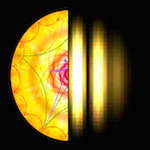The determination of fundamental parameters of stars is of paramount importance in astrophysics, in particular to understand the properties and the formation of exoplanets, to improve our understanding of the physical processes in stars, and to study the structure and evolution of our Galaxy. Two techniques that allow us to reach a precision of a few percent in these parameters are asteroseismology and interferometry. The combination of these two for the characterization of the same star is particularly powerful because it allows one to remove degeneracies in the parameter determination and to tend towards a unique solution.
We are experiencing an extremely rich period in this field with the conjunction of the K2 survey, ground-based SONG telescope, the next major photometric surveys TESS (2018) and PLATO (2025), the maturity of the interferometric networks (2nd generation instrumentation on the VLTI of ESO such as GRAVITY, development of adaptive optics on CHARA) and all of this complemented with the release of the first and subsequent Gaia data (2016-2017).
For advancing in many areas of astrophysics, fundamental stellar parameters need to be determined with accuracies of 5% on mass and 10% on age. This requires an effort in modeling the internal structure and atmospheres of stars, which can be tested and improved through the combination of interferometry and asteroseismology. The quality of Gaia parallaxes will impose a new view of the HR diagram, with the precision of interferometric angular diameters being the dominant source of uncertainty for linear radii, and the combination with asteroseismology yielding powerful measurements of stellar masses and ages.
In this workshop experts from the interferometry and asteroseismology communities will gather together to discuss ongoing collaborations between the two fields and explore new synergies to be developed in the context of the future ground-based instrumentation and space missions.
Confirmed invited speakers : Tim White (Aarhus Univ.), Antoine Merand (ESO), Nicolas Nardetto (OCA), Denis Mourard (OCA), Gail Schaefer (GSU), Andrew Mann (UT Austin), Remo Collet (Aarhus Univ.), Conny Aerts (Leuven Univ.), Isa Brandao (CAUP), Christian Hummel (ESO), Rene Andrae (Heidelberg)


